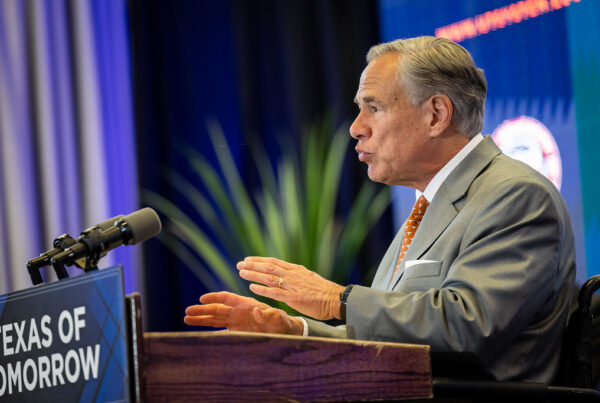From KUT News:
If you live in Austin, you probably don’t spend much time thinking about your local electric utility unless you lose power or you’re paying your bills. But, as an Austin Energy customer, you have a voice in how the utility operates. That means you can weigh in on energy issues big and small.
Consider the moontower.
Austin’s unique 150-feet-tall street lights were not so special back in the 1800s. Plenty of cities had them. As lighting technology advanced, Austin residents made a decision to keep them.
As a result, these lights have become an iconic part of the city’s culture. But maintaining them is not cheap: It has cost millions of dollars through the years.
Spending that kind of money on outdated — though locally beloved — electric infrastructure might not be as easy in some other Texas cities, because they don’t have a publicly owned utility.
“Because we are community-owned, the community has a voice in how we do our business,” Lisa Martin, chief operations officer with Austin Energy, said.
Public power
In a lot of other Texas cities, there is no single electric utility — let alone a public one.
In places like Dallas, Houston and Fort Worth, big power companies generate electricity. There are separate transmission companies that own the wires that move the energy around. Then there are companies called retail electric providers that buy the electricity wholesale and sell electricity plans to homes and businesses, kind of like a cellphone company sells a service plan.
Generally speaking, these companies are for-profit enterprises. They operate to make revenue to pay off company owners or investors.
In Austin, it’s different. Here, one utility operates everything from power generation to transmission to billing — all as a part of city government.
“Austin Energy is unique in that it is vertically integrated,” Martin said. “We are basically end-to-end providers.”
The Austin City Council acts something like the utility’s board of directors. That makes Austin Energy customers, who live within city limits, something like shareholders. It’s worth noting, though, that some Austin Energy customers do not live within the city boundaries.
The system means the utility can focus on things that are important to its customer base even if it costs money. Because Austin Energy is a part of city government, Austinites have a voice in some of the biggest issues confronting power companies today.
Like the really big issues.
The future of energy
For Kaiba White, a climate policy specialist for the nonprofit group Public Citizen, global warming is her generation’s “existential challenge.”
“The climate is changing faster than we can adapt to it, and we need to slow that down,” she said on a recent spring morning at the group’s state office in downtown Austin.
To help slow it down, she has spent her career battling carbon-intensive coal power plants around in Texas. But she can also take up the fight in her own city.
She serves on an advisory board called the Electric Utility Commission, a panel of citizens appointed by City Council to advise on Austin Energy policy. Lately, there has been a lot to advise on.
To ensure the city will meet its electricity needs far into the future, Austin Energy is in the process of working on a document with a somewhat clunky title: The Resource, Generation and Climate Protection Plan.
“It’s a really important document,” White said.
The plan identifies the sources from which Austin will secure electricity (Austin Energy operates its own power plants, but also brings in power through contracts with wind, solar and other energy providers). It also outlines how the utility hopes to meet a citywide goal of going carbon neutral by the year 2040 to fight climate change.

Power lines are shown at the Austin Energy substation.
Renee Dominguez / KUT News
This year, disagreement erupted between Austin Energy and some members of the commission when the utility presented the climate plan. White and others wanted to see Austin Energy pivot away from fossil fuel power plants faster.
That includes dropping its stake in a coal plant it had planned to divest from a years ago. It’s had trouble breaking its contract with the plant’s co-owner, the Lower Colorado River Authority.
So far, Austin Energy seems to think some of those ideas are unrealistic.
“I think where there comes some tension is just how fast we can move into certain technologies,” White said, “and how quickly we can retire certain types of generation, whether we can leave the whole concept of burning things to produce electricity behind us.”
Because this is all happening as part of a public process, that “tension” she describes has grabbed headlines. People have gone to Utility Commission meetings and City Hall to give their opinions. The debate has even led to a delay in when Austin Energy might get a generation plan to the City Council.
This kind of process wouldn’t happen if Austin didn’t have a public utility. Simply put, you don’t get to go to a private company and tell it how to run its business. But because Austin Energy is everybody’s business, everybody gets a say.
“The community has a voice in how things go and whether that’s through the commissions or public comment periods,” Martin said. “They have an opportunity to share their voices and values.”
Does it make running the utility more challenging?
“It sometimes makes it messy, because our job is to make sure that we’re providing every aspect of our mission,” she says. “That involves a fair amount of tradeoffs and a lot of balancing.”
Public vs. private
Martin says a big part of Austin Energy’s mission is simply running a successful utility. The city is counting on that not only for reliable and affordable energy, but also for money.
Revenue Austin Energy generates delivers millions of dollars for city programs annually. This years, it’s expected to inject around $124 millioninto Austin’s general fund.
According to the utility, that money is used to pay for things like parks and libraries. Austin’s 311 line is also funded and operated by the utility.
Critics of public power say spending utility revenue on public programs is a bad thing. Many of those critics want to break up public utilities and introduce private competition into Austin. They say it could lower bills. It’s worth noting that, in most legislative sessions, at least one lawmaker tries to do that.
But public power supporters say putting utility money into the general fund helps keep city taxes lower. They argue it’s better to have revenue going back into the city than to pay shareholders on Wall Street, as would happen under a for-profit system.
It’s worth noting that Austin Energy does not simply make money by selling electricity to customers in its service area.
Because of the way the Texas energy market works, the utility can make millions in revenue by selling the electricity it generates onto the Texas grid where it can go to power customers outside Austin.
Martin points to lower average energy bills in Austin, thanks in part to higher energy efficiency standards, to make the point that the utility remains more affordable than most in Texas.
The revenue “is not for the investors,” she said. “It’s for community programs and it’s ultimately to keep rates lower for our customers.”
That’s not to say those rates haven’t been going up. Winter storms, fuel costs and extremely hot summers have driven up the price of electricity in Texas overall.
The average Austin Energy customer is paying over $2 more per month this year due torate and fee increases last year. Bills are expected to rise again next year by about $1 more a month thanks to future rate hikes. That’s upset customers.
But even some critics of the utility’s policies are among its biggest defenders as a public utility.
“I am often a thorn in Austin Energy’s side pushing them to do more,” White said. “But they’re still my favorite electric utility in the state.”
That suggests one other benefit of public power: You know who to go to to complain.
After all, if you live within Austin city limits, you elect the board of directors when you vote for City Council.
















